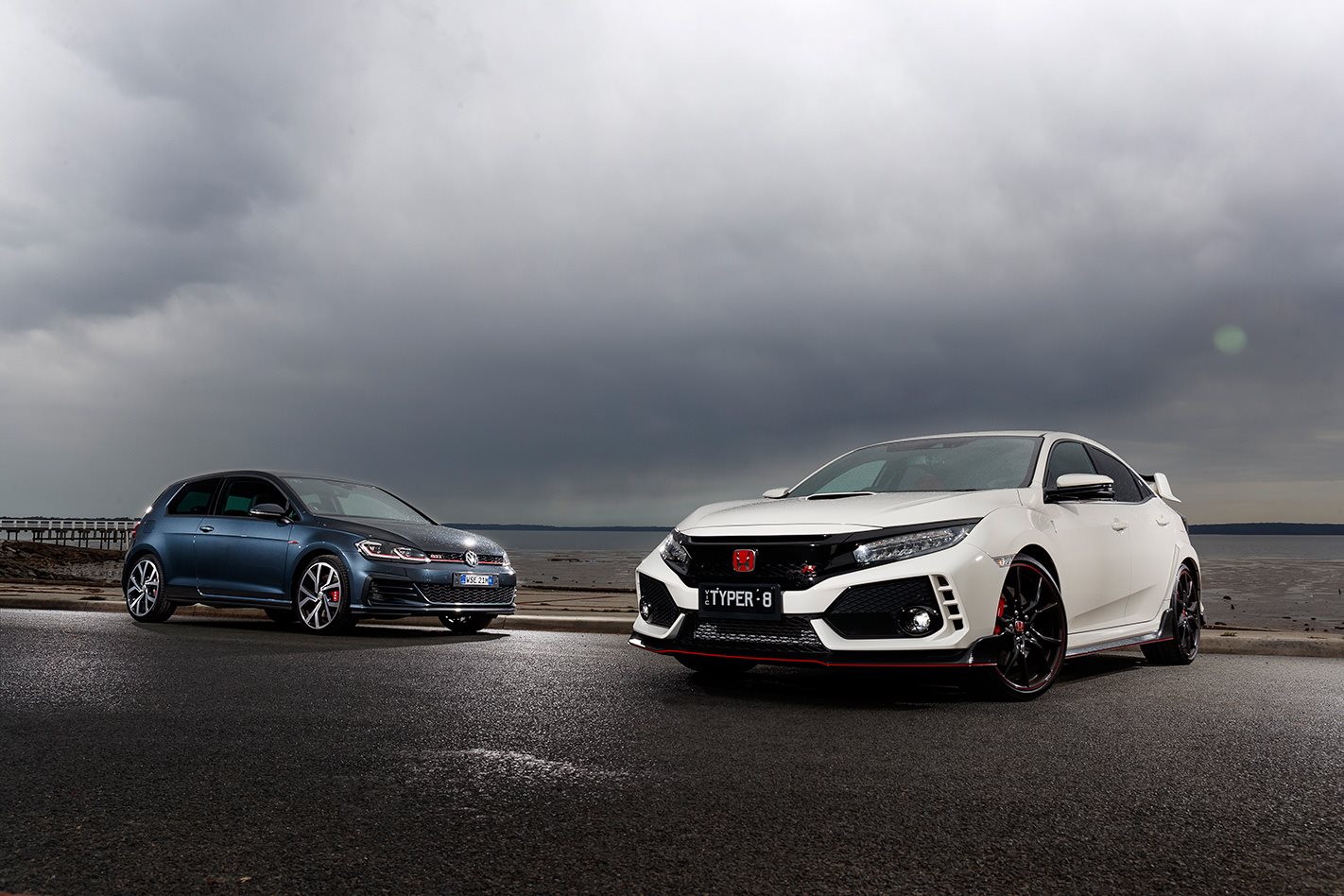Hallelujah, it’s raining hot hatches. In the coming months a flotilla of fast five-doors will reach Australia, including the Focus RS Limited Edition, new Megane RS and Hyundai’s i30 N.
However, beating them all to market is the Honda Civic Type R. It’s an iconic model, though local exposure has been limited to the underwhelming FN2, a car that was as much the work of Honda’s accountants as its engineers.
Honda’s sporting reputation in Australia was largely built on the back of the DC2 Integra Type R, one of the finest front-drivers, and it’s this reputation that the likes of the NSX and new Civic Type R has to rebuild. The mechanical make-up is promising.
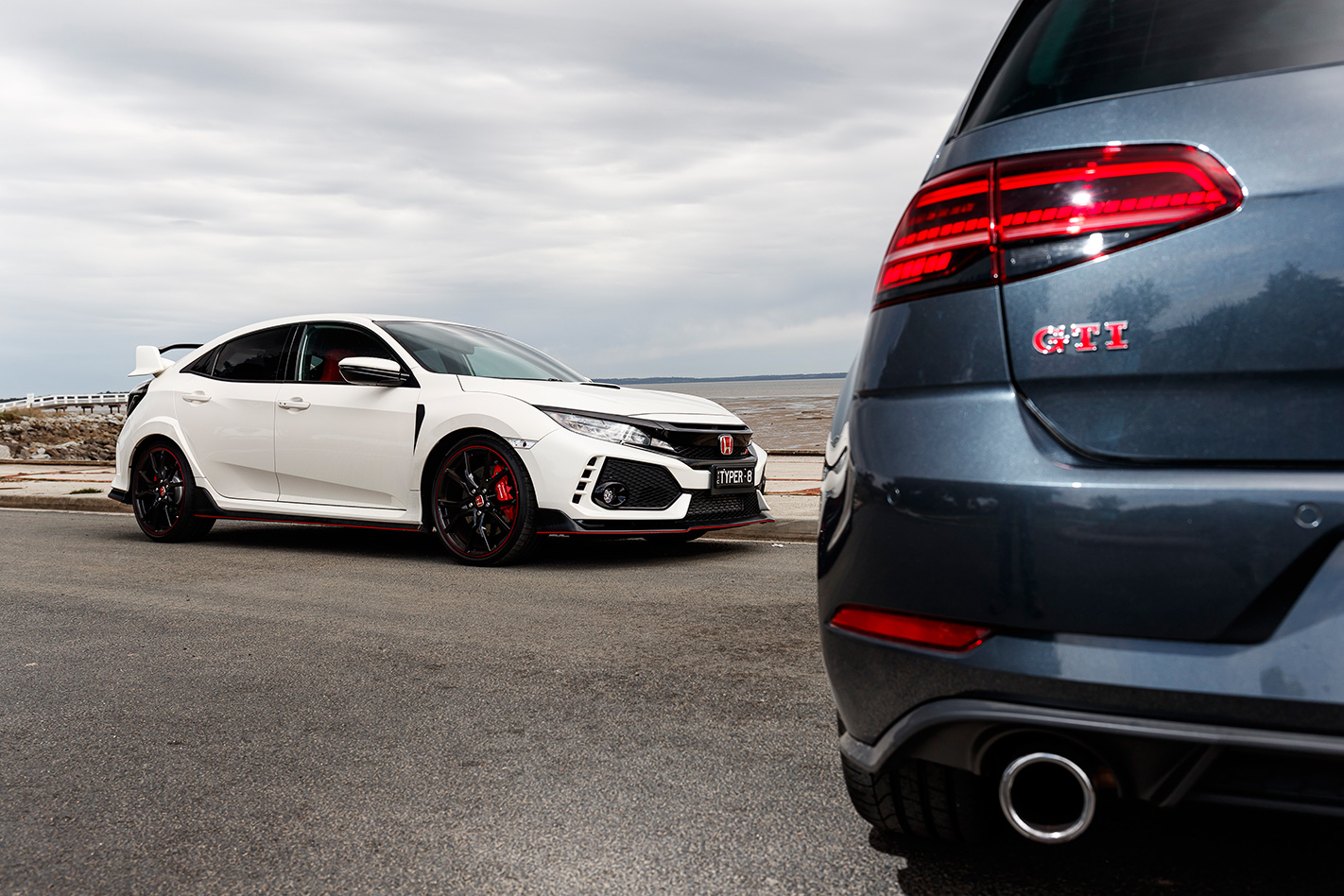
A six-speed manual is the only transmission option while a helical limited-slip diff apportions power between the front wheels. Keeping those wheels planted is a dual-axis front suspension, which like Ford’s RevoKnuckle and Renault’s PerfoHub designs, separates the steering knuckle from the strut to reduce torque steer, while an independent multi-link setup returns at the rear for the first time since the second-gen (2001-’06) EP3.
Wheels are 20 x 8.5-inch front and rear wearing the latest 245/30 Continental SportContact6s that hide Brembo brakes and three-mode adaptive dampers. Honda proved the Type R’s effectiveness by setting a 7min43.80sec lap of the Nurburgring Nordschleife, a record for a front-wheel drive car, eclipsing the previous mark set by the VW Mk VII Golf GTI Clubsport S.

The Performance Edition 1 (PE1) picks up the baton passed by the Mk VII Performance Pack – a Golf with a sharper sporting edge for the keen driver – albeit with a few key tweaks, the first of which is the deletion of two doors.
VW Australia has bowed to the wishes of enthusiasts and re-introduced the three-door Golf, but they’ll need to be quick, as just 150 Performance Edition 1s will land on Aussie shores for $47,990 in a choice of White, Silver or our test car’s Dark Iron Blue.
Mechanically, the PE1 scores an 11kW/20Nm boost over the standard GTI (and previous GTI Performance) to 180kW/370Nm, which has necessitated the move to the stronger seven-speed dual-clutch gearbox.

Its note is obviously artificial, sounding not dissimilar to a diesel at low rpm, but once rolling there’s little to complain about in the way it shifts down the road. The trademark DSG hesitation can make smooth takeoffs a challenge, though the more you treat it like a manual with an electronically controlled clutch (which is what it is) rather than a traditional auto the happier your experience will be.
Cheaper Volkswagen Golf R Grid Edition announced
A bigger problem is the conservatism of the traction control/ESP, which can’t be completely deactivated and even in ‘Sports’ mode cuts power drastically once it detects wheelspin. This has traditionally been the bugbear in extracting quick acceleration times from front-drive, DSG-equipped Golfs.
Launch control uses too many rpm, the resultant wheelspin causing a tantrum from both ESP and driver as tenths tick frustratingly away. Thankfully, VW now allows some driver input into the process, as evidenced by the Golf’s 6.06sec 0-100km/h effort, besting its claim by 0.14sec and our best time in the previous GTI Performance by more than 0.7sec.
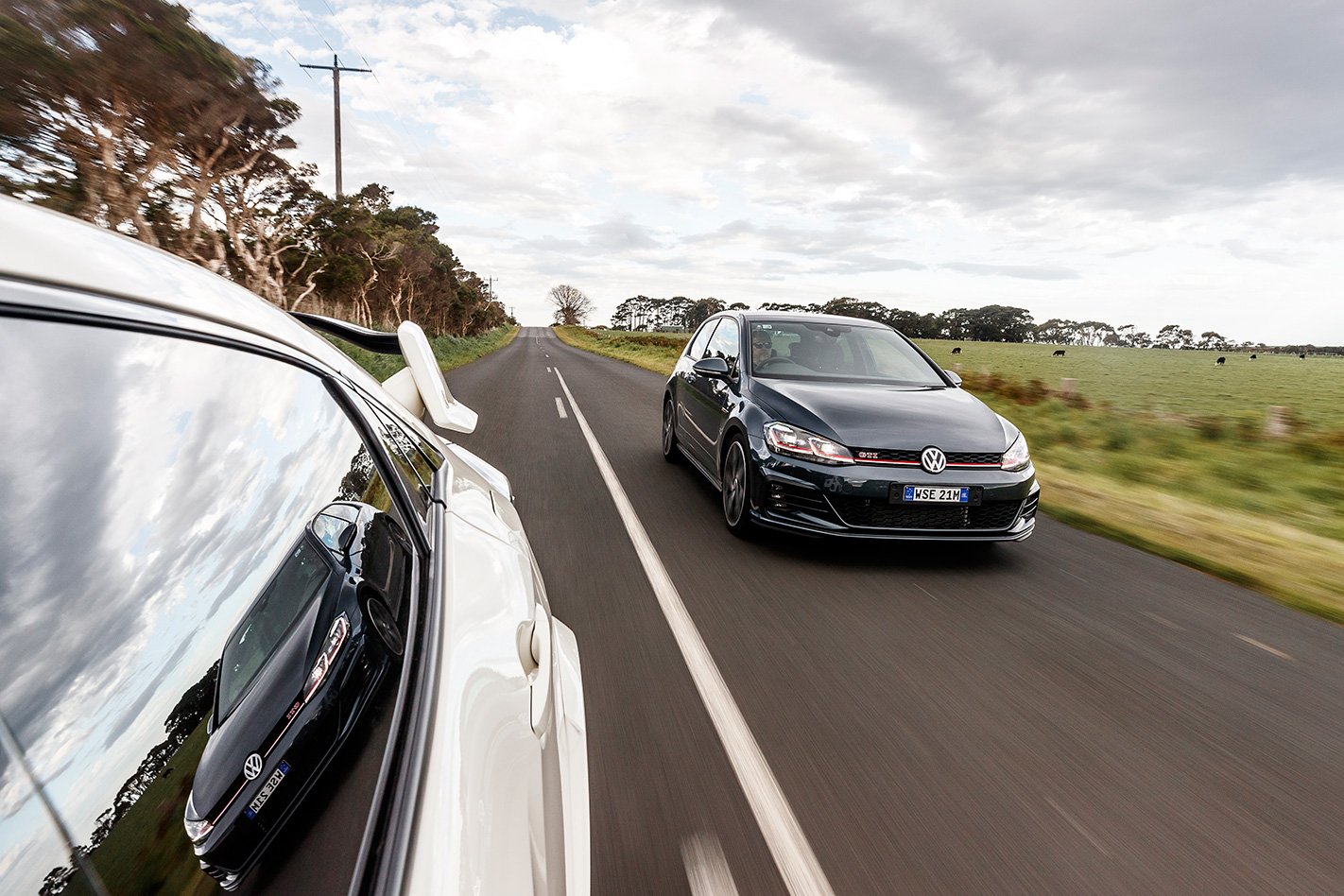
Around 2000rpm is the sweet spot, allowing just a hint of wheelspin before the shortly stacked ratios (second stretches to just 86km/h and third is done by 125km/h) pull the Golf across the quarter mile in 14.21sec at 166.13km/h. Despite the need to shift your own gears, the Civic is much quicker – with a far superior power-to-weight ratio (165kW/tonne vs the VW’s 133kW/tonne) it was always going to be.
Its 5.82sec 0-100km/h and 13.84sec at 170.15km/h quarter mile numbers put it lineball with the Renault Megane RS275 Trophy-R as the fastest front-driver we’ve ever tested, but extracting the last tenth or two is hard work. Traction is much better than you’d expect, but managing wheelspin in first gear costs time and the 0-100km/h number is hurt by second gear hitting the limiter at 99km/h.
Still, the slick shift minimises time loss and the combination of that short gearing and turbo torque makes the Type R a roll-on rocket. Overtaking from 80-120km/h takes just 2.8sec in third and 7.7sec in sixth – by way of comparison, a manual HSV GTS needs 2.8sec and 7.6sec respectively.
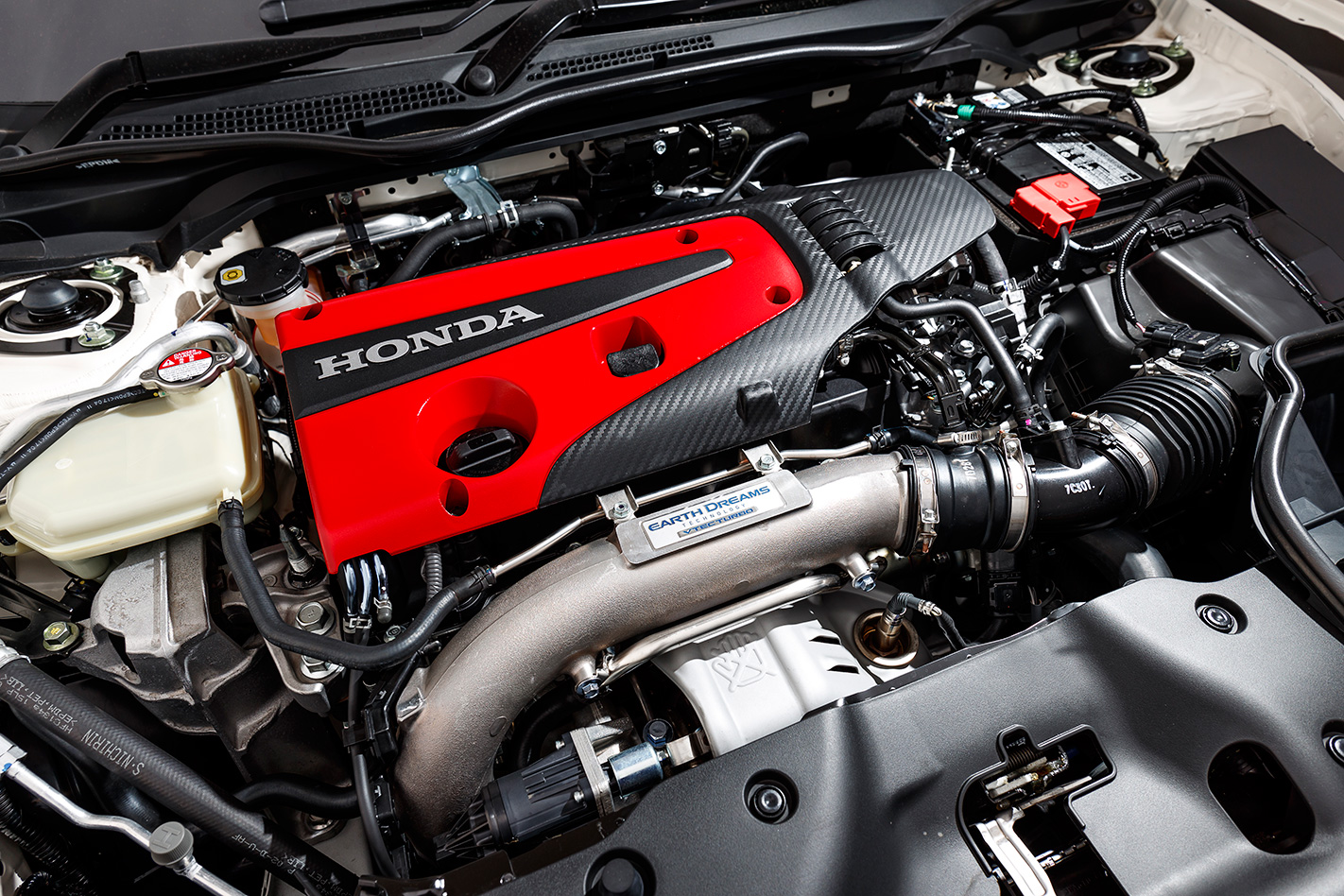
Its biggest issue is heat soak; its quickest acceleration times came on the seventh or eighth run, however, on its first run it was 0.4sec quicker to 170km/h despite the slower benchmark times. And this on a 17°C day. The good news from a driving point of view is that this is one of very few cracks in the Type R’s armour.
Honda has built a proper weapon. What impresses most initially will depend on the environment in which you first experience the Type R. At a relaxed pace it’s likely to be the ride quality.
With the drive mode selector set to Comfort the Civic has an almost Porsche-like ability to deliver compliance on 20-inch rims and low-profile tyres; on poor roads it can turn a little jittery, but by and large the Honda absorbs your typical bumpy Aussie back road in a manner a Focus RS or previous-gen Megane RS can only dream about.

On dry surfaces the front-end is nailed to the road, capable of supporting incredible entry speeds, yet the diff more often than not ensures a tidy exit by pulling the front in the intended direction rather than letting it slip wide under power.
It’s not particularly playful; the chassis setup errs towards stability and though it’s possible to shift the rear slightly mid-corner, the strength of the front-end renders any attempts to do so largely redundant.
The steering is quick and accurate and the brakes are powerful with the ABS perfectly matched to the available tyre grip – its 34.2m stop from 100-0km/h bested the Golf by more than four metres. Those who like to feel a car move around may find its handling a little one-dimensional, but its composure when being driven as hard as possible means it’s far from uninvolving.

The Type R is a tough act to follow and to be brutally honest in terms of outright ability the Golf doesn’t even get close. In isolation it’s a highly capable hot hatch but any attempts to carry similar corner speed to the Civic results in severe pitch and roll and the tortured howling of Pirellis.
Wearing 225/35 tyres all ’round, the VW has a smaller footprint than the Honda but its primary shortcoming is its soft suspension. Even in Sport mode it leans heavily under lateral load and mid-corner bumps the Civic shrugs off nonchalantly have the Golf thumping into its bump stops, its dampers utterly out of ideas.
Inputs have to be made with care to avoid upsetting the car – for instance, clumsily jamming the brakes on will trigger the ABS and have the rear skipping sideways – yet when really driving the VW hard it needs to be cajoled or bullied into doing what you want, at which point the non-switchable ESP is only too happy to intervene.
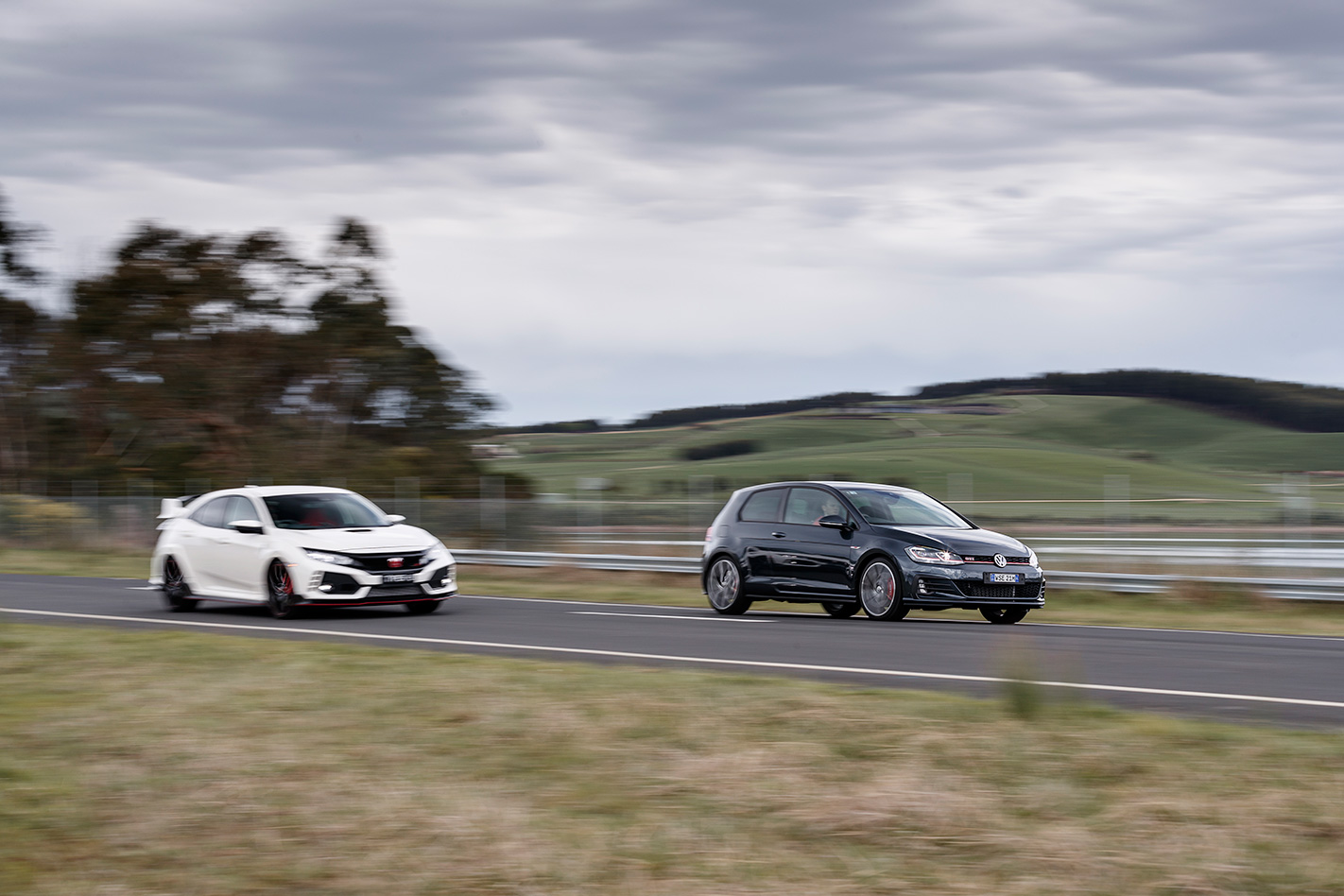
Up to eight-tenths the GTI is great, but beyond that and even this Performance Edition 1 is clearly operating out of its comfort zone. As is so often the case, though, the Golf has other tricks up its expertly engineered sleeves.
Its ride shames many a premium sedan and its interior is leagues ahead of the Civic’s in quality and feel, with soft-touch plastics and leather surfaces, a giant 9.2-inch touchscreen, flashy digital instruments and far superior rear accommodation (there are air vents, for a start), though the three-door layout means passengers will need to be a little more dexterous than usual.
Everything the driver interacts with in the Civic is top notch. The driving position is great, the deep Recaro seats superb, steering wheel spot-on in diameter and the alloy gear knob a perfect fit for your palm, though likely to give a few nasty shocks in very hot or cold weather.

But if the interior isn’t for everyone, it’s nothing compared to the exterior – the latest Civic Type R is not a car for shrinking violets. Its styling is a riot of angles, lines and vents, like something from a Japanese comic book come to life, but love it or hate it it has undeniable presence.
In contrast the Golf might as well be invisible. The Mk7.5 facelift has been a subtle one, mainly consisting of LED lights at both ends and revised bumpers and grilles, and while there are some neat design touches such as the rear diffuser and spoiler, it’s a car for those who like to blend in rather than stand out.

If you’re after a daily driver that doubles for the occasional twisty road outing there’s plenty to recommend as the GTI is an excellent all-rounder, but in judging these two as performance cars, the Type R is a clear winner.
It offers speed and involvement that would give a Focus RS pause for thought on road and track yet is much more liveable. Hallelujah, it’s raining hot hatches, and Honda has built a cracker.
| u00a0 | Honda Civic Type R Specs | Volkswagen Golf GTI Performance 1 specs |
| Engine | 1998cc inline-4cyl, DOHC, 16v, turbocharger | 1984cc inline-4cyl, DOHC, 16v, turbocharger |
| Power | 228kW @ 6500rpm | 180kW @ 5000-6200rpm |
| Torque | 400Nm @ 2500-4500rpm | 370Nm @ 1600-4300rpm |
| Transmission | 6-speed manual | 7-speed dual-clutch |
| Weight | 1380kg | 1352kg |
| Price as tested | $50,990 | $47,990 |
| Pros | Strong engine; huge grip; gearshift | Ride; interior quality; exclusivity |
| Cons | Cheap interior; polarising looks | Too soft for ultimate thrills; unkillable ESP |
| Star rating | 4.5 out of 5 | 4 out of 5 |


